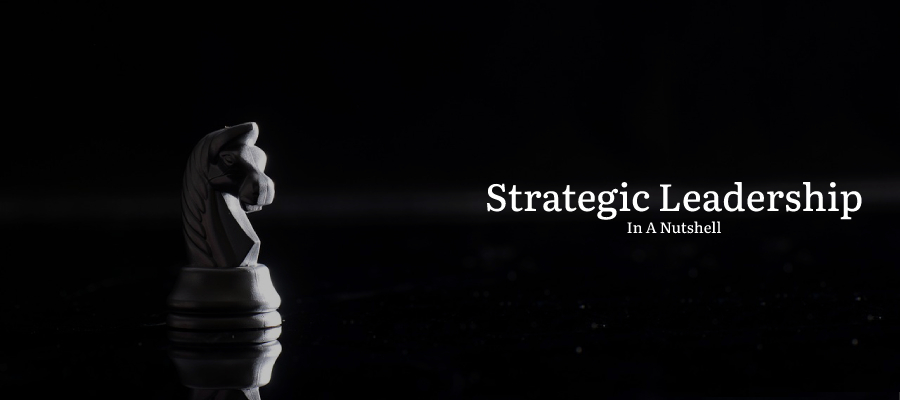Strategic Leadership in a Nutshell
Let’s discuss the complex topic of strategic leadership and break it down into simple terms for easy understanding. Many times, the complexity of Strategic Leadership is underappreciated. This is a mistake because it is not as simple as some have tried to make it out to be. However, the individual steps can be broken down into simple terms.
So, why is strategic leadership so complicated? For many reasons, but I would imagine that such complexities begin with “thought.” Not everyone is a “thinker.” Strategic leadership requires the ability to think critically and creatively about an individual’s or organization’s future. Many people simply struggle with this. Moreover, strategic leadership requires continuous improvement and learning because it helps leaders make informed decisions and navigate uncertainty. Many are just not interested in continual development or learning.
Regardless, I contend that strategic leadership is crucial for success, whether you are a CEO or someone trying to lead your life. Unfortunately, it is a process. So, since many like to simplify things, here is an oversimplification of Strategic Leadership.
The first step in strategic leadership is strategic thinking. This is the ability to think about the future and understand where you currently are, where you want to go, and how you will get there. In this step, you are basically thinking abstractly and getting a rough outline of how things are and could be.
The next step is to honestly assess where you or the organization currently stand. This includes assessing the strengths, weaknesses, opportunities, and external and internal threats. By understanding the current state, you can make better decisions about where to focus your efforts and resources.
Once you clearly understand the current state, it’s time to hone the vision for where you want to go. For clarity, a vision is a clear, inspiring picture of the future that guides decision-making. It is important to involve trusted teammates in the development of the vision to ensure that it is something that everyone can get behind.
After developing a vision, the next step is to solidify the direction and align all actions and decisions toward that vision. This includes aligning the goals and objectives with the vision. By creating alignment, you can ensure everyone is working towards the same goal. More importantly, if you happen upon any roadblocks or walls, knowing your direction allows you to remain agile and navigate accordingly.
The next step is gaining commitment from the team. This means inspiring the team to believe in the vision and motivating them to take action. It’s about creating a sense of ownership and shared responsibility for achieving the vision. Essentially, you’re getting everyone tuned into WIIFM (What’s In It For Me).
Creating a strategic plan comes next. A strategic plan outlines (not defines) the specific actions that need to be taken to achieve the vision. It includes measurable goals, timelines, and resources. By creating a plan, you can turn your vision into something tangible. However, we do not create rigid definitions. Again, we want to remain agile in the face of adversity. For that, we need a little flexibility in the plan.
Then comes the implementation of the plan. This includes addressing potential obstacles, allocating resources, and managing risk. Of course, it’s important to proactively identify and address any issues that may arise during the implementation phase.
Effective communication is also critical for gaining commitment and creating alignment in strategic leadership. Developing a clear and consistent communication plan aligned with the organization’s vision is essential. This includes communicating the vision and strategy to all stakeholders and encouraging open and transparent communication throughout the organization. It’s the “what,” “why,” and “what success looks like.”
Next comes development and training. Let me be clear that developing strategic leadership skills is a lifelong journey. It’s essential to continually assess your abilities and identify improvement areas. This includes developing the skills to think strategically, lead your team toward a vision, navigate uncertainty, and effectively implement and communicate the plan. Nonetheless, we must get started on this process immediately. Like any ‘pro,’ we train and practice like we play.
The final step of strategic leadership is assessing progress. It’s essential to track your progress against your goals and timelines and make adjustments as needed. This includes evaluating the effectiveness of your plan, identifying any roadblocks or challenges you encountered, and celebrating your successes. Regularly assessing progress can ensure you’re on track to achieve your vision and make any necessary adjustments. It can also keep everyone motivated.
Strategic leadership is a complex topic that can be difficult to understand. Clearly, each one of these steps has a dozen or so ‘sub-steps.’ However, it becomes easier to grasp by breaking it down into simple terms and understanding the steps involved. Remember, being a strategic leader is a continuous journey, and it’s essential to continually develop your skills and assess your progress. Again, please keep in mind that this article is a drastic oversimplification. I am merely simplifying things to give a rough idea of the various steps involved. And with these things in mind, it should become clear why I am not a fan of Servant Leadership.




